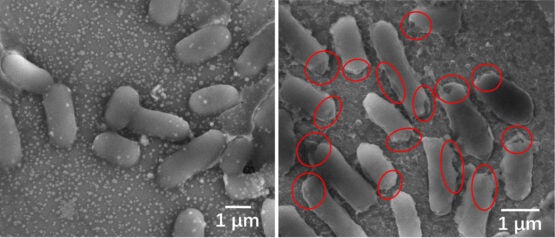At least 2 billion people worldwide regularly drink water contaminated with disease-causing microbes.

Disinfectant powder is stirred in bacteria-contaminated water (upper left). The mixture is exposed to sunlight, which rapidly kills all the bacteria (upper right). A magnet collects the metallic powder after disinfection (lower right). The powder is then reloaded into another beaker of contaminated water, and the disinfection process is repeated (lower left). (Image credit: Tong Wu/Stanford University)
Now, scientists at Stanford University and SLAC National Accelerator Laboratory have invented a low-cost, recyclable powder that kills thousands of waterborne bacteria per second when exposed to ordinary sunlight. The discovery of this ultrafast disinfectant could be a significant advance for nearly 30 percent of the world’s population with no access to safe drinking water, according to the Stanford and SLAC team. Their results are published in a May 18 study in Nature Water.
“Waterborne diseases are responsible for 2 million deaths annually, the majority in children under the age of 5,” said study co-lead author Tong Wu, a former postdoctoral scholar of materials science and engineering (MSE) in the Stanford School of Engineering. “We believe that our novel technology will facilitate revolutionary changes in water disinfection and inspire more innovations in this exciting interdisciplinary field.”
Conventional water-treatment technologies include chemicals, which can produce toxic byproducts, and ultraviolet light, which takes a relatively long time to disinfect and requires a source of electricity.
The new disinfectant developed at Stanford is a harmless metallic powder that works by absorbing both UV and high-energy visible light from the sun. The powder consists of nano-sized flakes of aluminum oxide, molybdenum sulfide, copper and iron oxide.
“We only used a tiny amount of these materials,” said senior author Yi Cui, the Fortinet Founders Professor of MSE and of Energy Science & Engineering in the Stanford Doerr School of Sustainability. “The materials are low cost and fairly abundant. The key innovation is that, when immersed in water, they all function together.”
Fast, nontoxic, and recyclable
After absorbing photons from the sun, the molybdenum sulfide/copper catalyst performs like a semiconductor/metal junction, enabling the photons to dislodge electrons. The freed electrons then react with the surrounding water, generating hydrogen peroxide and hydroxyl radicals – one of the most biologically destructive forms of oxygen. The newly formed chemicals quickly kill the bacteria by seriously damaging their cell membranes.

Microscopic images of E. coli before (left) and after disinfection. The bacteria died quickly after sunlight produced chemicals that caused serious damage to the bacterial cell membranes, as shown in the red circles. (Image credit: Tong Wu/Stanford University)
For the study, the Stanford and SLAC team used a 200 milliliter [6.8 ounce] beaker of room-temperature water contaminated with about 1 million E. coli bacteria per ml [.03 oz.].
“We stirred the powder into the contaminated water,” said co-lead author Bofei Liu, a former MSE postdoc. “Then we carried out the disinfection test on the Stanford campus in real sunlight, and within 60 seconds no live bacteria were detected.”
The powdery nanoflakes can move around quickly, make physical contact with a lot of bacteria and kill them fast, he added.
The chemical byproducts generated by sunlight also dissipate quickly.
“The lifetime of hydrogen peroxide and hydroxy radicals is very short,” Cui said. “If they don’t immediately find bacteria to oxidize, the chemicals break down into water and oxygen and are discarded within seconds. So you can drink the water right away.”
The nontoxic powder is also recyclable. Iron oxide enables the nanoflakes to be removed from water with an ordinary magnet. In the study, researchers used magnetism to collect the same powder 30 times to treat 30 different samples of contaminated water.
“For hikers and backpackers, I could envision carrying a tiny amount of powder and a small magnet,” Cui said. “During the day you put the powder in water, shake it up a little bit under sunlight and within a minute you have drinkable water. You use the magnet to take out the particles for later use.”
The powder might also be useful in wastewater treatment plants that currently use UV lamps to disinfect treated water, he added.
“During the day the plant can use visible sunlight, which will work much faster than UV and would probably save energy,” Cui said. “The nanoflakes are fairly easy to make and can be rapidly scaled up by the ton.”
The study focused on E. coli, which can cause severe gastrointestinal illness and can even be life-threatening. The US Environmental Protection Agency has set the maximum contaminant-level goal for E. coli in drinking water at zero. The Stanford and SLAC team plans to test the new powder on other waterborne pathogens, including viruses, protozoa and parasites that also cause serious diseases and death.
Yi Cui is director of the Precourt Institute for Energy and the Sustainability Accelerator in the Stanford Doerr School of Sustainability. He is also a professor of photon science at the SLAC National Accelerator Laboratory. Bofei Liu is now a research scientist at EEnotech Inc., a water purification spinoff co-founded by Cui. Tong Wu is on the faculty of Tonji University in Shanghai.
Other Stanford co-authors are Harold Y. Hwang, professor of applied physics in the School of Humanities and Sciences and professor of photon science at SLAC, and director of the Stanford Institute for Materials & Energy Sciences; former engineering postdocs Chong Liu, Jiayu Wan, Feifei Shi, Ankun Yang, Kai Liu and Zhiyi Lu; and former engineering PhD students Jie Zhao and Allen Pei.
Funding for the research was provided by the US Department of Energy.

